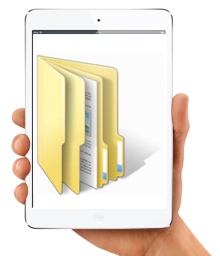The problem with the iPad

The iPad was one of those pieces of tech that people really didn't expect to succeed. Prior to Apple's entry into the market, Microsoft had tried — and essentially failed — to take the form factor into the mainstream, but the Cupertino, California, giant's vision of what a tablet device should be was an overnight success.

As the iPad matured, it transitioned from being a consumer electronics bauble into also being a serious tool used by enterprise, with Apple claiming that virtually all of the Fortune 500 and over 85 percent of the Global 500 companies currently deploying or testing iPads.
The iPad's ace up its sleeve was simplicity. Everything about the device was built around making it as easy to use as possible. But it's possible to take simplicity too far, especially when enterprise users are concerned, and there's one aspect of the iPad that Apple may need to address to keep enterprise users happy, and that's file system access.
Jean-Louis Gassée of The Guardian succinctly summed up the problem facing the iPad.
"On a 'real' PC," wrote Gassée, "the file system is visible, accessible; on the iPad, it's hidden. The act of creating, arranging, accessing files on a PC is trivial and natural. We know how to use Finder on the Mac and Explorer on Windows."
But things are different on the iPad.
See also Network and network troubleshooting apps for the iPhone and iPad
"On an iPad, you don't navigate a file system, but, instead, you launch an app that has its own trove of documents that it understands — but it can't 'see' anything else," Gassée pointed out.
The more you work on an iPad, the more you notice this.
If everything you do is done in a single word processing document or spreadsheet, or you spend most of your time flinging birds and pigs, then you might never notice a problem, but if you work on projects that rely on multiple files or multimedia — and by this I mean multimedia in the loosest sense possible, in that you need multiple types of media — then this is when things start to get tricky. Even doing something as simple as keeping together a set of images that go with a word processor document is hard. Most of the time, you end up resorting to using a cloud storage service, a situation that can be far from ideal for some.
While there's little doubt that simplicity is at the heart of Apple's decision to hide the iOS file system from view, security and data integrity also plays a part. Apps are sandboxed from each other, and cannot, in most cases, see or tamper with data that belongs to another app.
Apple's intentions are honorable.
One way that Apple could solve this file system dilemma is to create shared storage space on iOS devices that any app — with the right permission — can access. This would work much like how photo storage works, where apps can ask for permission to access the camera roll, and then have the ability to access, modify, and save files. This would allow those who wanted to manage projects from their iPads — or, for that matter, their iPhones — the ability to create folders to hold a variety of project files, and then give apps the ability to access these folders.
This would offer the best of both worlds. It would allow Apple to keep the iOS file system from view, while offering enterprise and power users the ability to do more with their iPads.